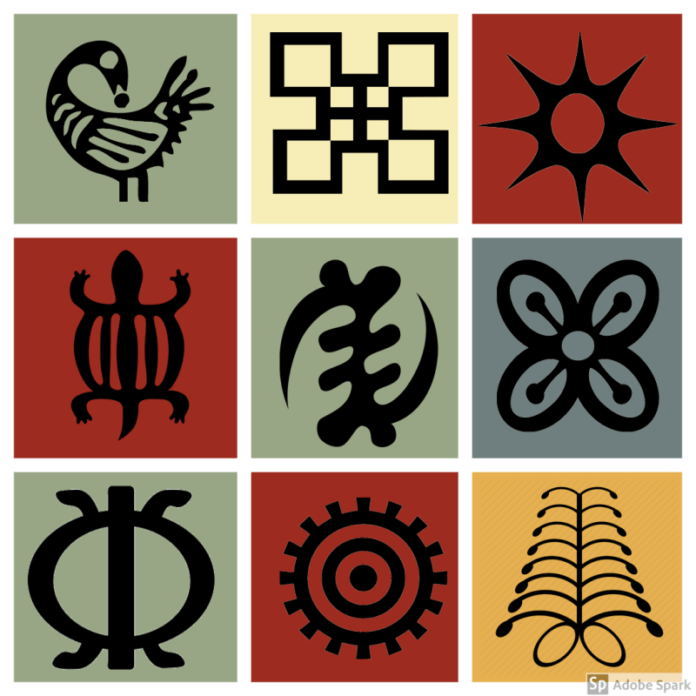
The Adinkra symbols are unique cultural expressions, concepts, values and traditional mythology of the Akan tribe of Ghana and Gyaman of Ivory Coast. The Adinkra symbols represent popular proverbs and maxims, record historical events, express particular attitudes or behavior related to depicted figures, or concepts uniquely related to abstract shapes.
There are more than 200 Adinkra symbols and meanings to each one of them.
Adinkra symbols and meanings
Most if not all Adinkra symbols and their meanings have been assigned a unique literal, symbolic and proverbial expression.
ADINKRAHENE
Chief of the Adinkra symbols : Symbol of greatness, charisma and leadership. This symbol is said to have played an inspiring role in the designing of other symbols. it signifies the importance of playing a leadership role.

AKOBEN
War horn : Symbol of vigilance and wariness. Akoben is a horn used to sound a battle cry.

AKOFENA
Sword of war: Symbol of courage, valor, and heroism. The crossed swords were a popular motif in the heraldic shields of many former Akan states. In addition to recognising courage and valor, the swords can represent legitimate state authority.

AKOKO NAN
The leg of a hen: Symbol of nurturing and discipline. The full name of this symbol translates to “The hen treads on her chicks, but she does not kill them.” This represents the ideal nature of parents, being both protective and corrective. An exhortation to nurture children, but a warning not to pamper them.

ANANSE NTONTAN
Spider’s web: Symbol of wisdom, creativity and the complexities of life. Ananse, the spider, is a well-known character in African folktales.

AKOMA NTOSO
Linked hearts: Symbol of understanding and agreement

ASASE YE DURU
The Earth has weight : Symbol of providence and the divinity of Mother Earth. This symbol represents the importance of the Earth in sustaining life.

AYA
Fern: Symbol of endurance and resourcefulness. The fern is a hardy plant that can grow in difficult places. “An individual who wears this symbol suggests that he has endured many adversities and outlasted much difficulty.”

BESE SAKA
Sack of cola nuts: Symbol of affluence, power, abundance, plenty, togetherness and unity. The cola nut played an important role in the economic life of Ghana. A widely-used cash crop, it is closely associated with affluence and abundance. This symbol also represents the role of agriculture and trade in bringing peoples together.

BI NKA BI
No one should bite the other: Symbol of peace and harmony. This symbol cautions against provocation and strife. The image is based on two fish biting each other tails.

BOA ME NA ME MMOA WO
Help me and let me help you : Symbol of cooperation and interdependence

DUAFE
Wooden comb: Symbol of beauty and cleanliness; symbols of desirable feminine qualities. The meaning of this symbol is characterized slightly differently in “The Adinkra Dictionary” and “The Values of Adinkra Symbols”; the former emphasizes more abstract qualities of feminine goodness, love and care, while the latter has a more literal interpretation, looking one’s best and good hygiene. In any case, the duafe was a prized possession of the Akan woman, used to comb and plait her hair.

DWENNIMMEN
Ram’s horns : Symbol of humility together with strength. The ram will fight fiercely against an adversary, but it also submits humbly to slaughter, emphasizing that even the strong need to be humble.

EBAN
Fence: Symbol of love, safety and security. The home to the Akan is a special place. A home which has a fence around it is considered to be an ideal residence.

GYE NYAME
Except for God : Symbol of the supremacy of God. This unique and beautiful symbol is ubiquitous in Ghana. It is by far the most popular for use in decoration, a reflection on the deeply religious character of the Ghanaian people.

KWATAKYE ATIKO
Hair style of an Asante war captain : Symbol of bravery and valor. This symbols is said to be a special hair style of Kwatakye, a war captain of old Asante.

ME WARE WO
I shall marry you: Symbol of commitment, perseverance

SANKOFA
Return and get it: Symbol of importance of learning from the past


SESA WO SUBAN
Change or transform your character: Symbol of life transformation. This symbol combines two separate Adinkra symbols, the “Morning Star” which can mean a new start to the day, placed inside the wheel, representing rotation or independent movement.

WO NSA DA MU A
If your hands are in the dish: Symbol of participatory government, democracy and pluralism. From the aphorism, “Wo nsa da mu a, wonni nnya wo” — “If your hands are in the dish, people do not eat everything and leave you nothing.”

The Adinkra symbols and meanings above are few of the many adinkra symbols. The few that have been highlighted are enough to get you started.
You will find adinkra symbols on many exported items, such as furniture, sculpture, pottery, t-shirts, hats and other clothing items in addition to fabric. Another popular use of the symbols is for tattoo art. You should further research the meaning of any symbol before deciding to use it for a tattoo to ensure it conveys the message you desire.
